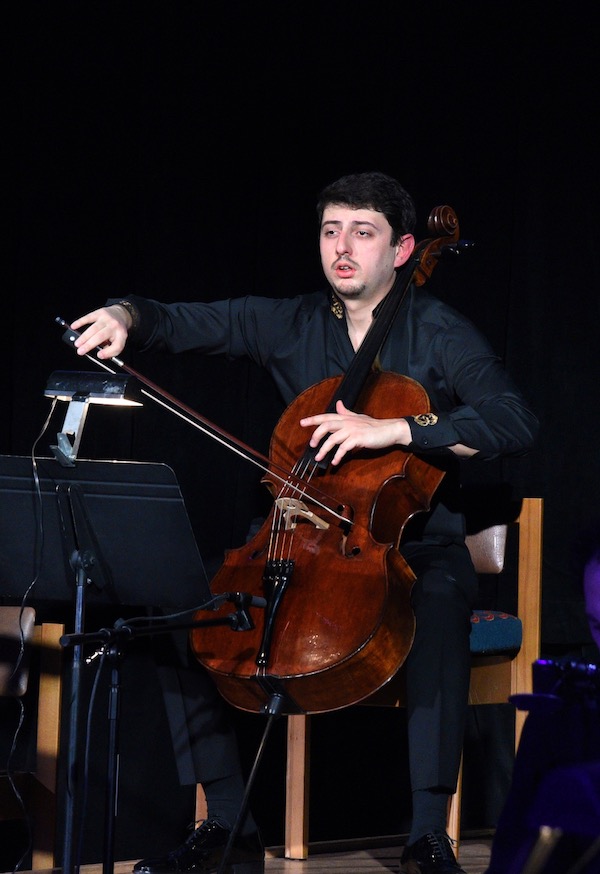PostClassical Ensemble fetes Armenian music and history at National Cathedral

Armenia, the first country to declare Christianity its state religion, has a long and glorious cultural history. PostClassical Ensemble’s latest cultural festival, “The Color of Pomegranates,” is honoring that tradition with a series of events, which reached a pinnacle Wednesday night with a spectacular multimedia performance filling the nave of Washington National Cathedral. The Armenian ambassador, who spoke before the event, welcomed members of the U.S. Congress and other dignitaries to the event, which marked the 100th anniversary of U.S.-Armenian diplomatic relations.
The evening opened with the most authentic performance, an improvised duet featuring two duduk players, Jivan Gasparyan and his grandson, Jivan Gasparyan, Jr. The Armenian duduk, a double-reed folk instrument made of apricot wood, sounds like a cross between an organ pipe, a soft brass instrument like a cornetto, and the human voice. The two expert players overlapped one another in the traditional duo format, covering each other’s breaths and one supporting the other with a drone or answering accompaniment, to mesmerizing effect.
Armenian composer Vache Sharafyan provided the evening’s two main courses: the world premiere of An Armenian Odyssey, a new work for chamber orchestra and vocal trio, and his Cello Concerto No. 2. The two halves were joined here as accompaniment to a striking cinematic performance by Kevork Mourad. This American artist, born in Syria of Armenian heritage, stood toward the back of the orchestra, and the movement of his hands drawing was shown on large video screens as he created narrative scenes. Conductor Angel Gil-Ordóñez masterfully managed the spatial and coordination challenges of this complex evening.
Sharafyan, a collaborator for two decades with Yo-Yo Ma’s Silk Road Project, works generally in the light, folk-crossover style associated with that group. Armenian Odyssey continued in that vein. The work traces the life of the troubadour Sayat-Nova, with prominent solo parts for the Zulal Trio, a group of women who specialize in singing Armenian folk songs in collegiate a cappella-style arrangements. Amplified so as to be heard in the cathedral’s vast, echoing acoustic, Teni Apelian, Anais Tekerian, and Veraz Markarian keened in close harmony, evoking Armenian folk song in their solo passages.
The strings shadowed them, in a mostly tonal harmonic palette clustered with folkloric dissonances and cantillation. Prominent solo parts in the orchestra included the rich English horn of Fatma Daglar, imitating the duduk, and gleaming, moody trumpet of Chris Gekker. Violinist Netanel Draiblate led a Hollywood string romance with his blues-tinged solo.
Although the music was mostly slow and atmospheric, the final section marked the Muslim invasion that ended the poet’s life, after he had become a priest and retreated to a monastery. Near the end the three singers took up ocarinas for ethereal, wind-like solos that gave the sense of time passing. The piece segued seamlessly into another duduk solo, played by Gasparyan the younger, which covered the entrance of musicians for the second piece.
Cellist Narek Hakhnazarian had to be amplified as well for his solo part in Cello Concerto No. 2 from 2013, during which he played on a spotlit platform behind the orchestra. Its three movements were adapted to the theme of the second part of the evening, “Diaspora and Rebirth.” The faster middle movement, with driving music and Hakhnazarian’s sharp-edged running notes, accompanied the depiction of the Armenian Genocide, the very existence of which the United States government officially recognized only this past December.
Hakhnazarian excelled in the slower outer movements, music intended now to match the drawings evoking the Armenian diaspora and the Velvet Revolution in 2018. (The latter was a series of widespread peaceful protests there that forced a change in government.) Especially in the cadenza, a series of longing upward lines, the cellist’s graceful articulation and laser-precise intonation seduced the ear. The concerto had a sort of co-soloist in the clarinet, played here with soulful passion by Garrick Zoeter, echoed at times by Edna Huang on bass clarinet.
Not only the video but animated and colored lighting, projected onto the vault and great piers of the cathedral, contributed to the sense of being surrounded by this atmospheric work. The conclusion of the concerto, alluding to a repeating Bach-style harmonic pattern without being a direct quotation, offered a hopeful glimpse into the future of a country and people that have confronted overwhelming sadness in their long history.
Other events in the “Color of Pomegranates” Armenian cultural festival continue through March 14. postclassical.com

Posted Mar 06, 2020 at 9:06 pm by Mercedes Rubio
It was absolutely beautiful. A mesmerizing multimedia experience masterfully coordinated by Angel Gil Ordonez. Congratulations !